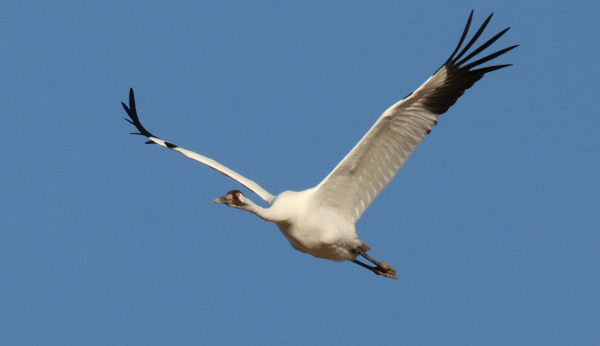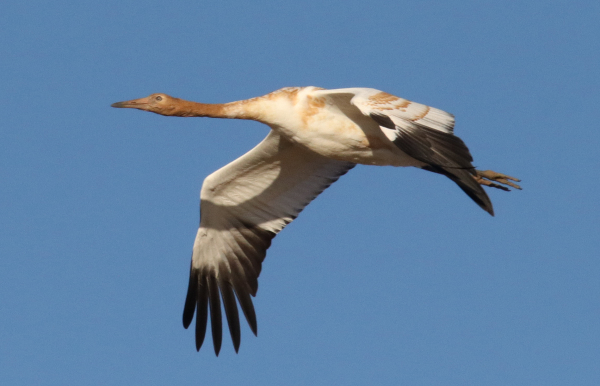As I followed a flock of one of the most regal birds in the Americas through my camera lens, I couldn’t believe that after flying by me into ever-better afternoon sunlight, the 5 Whooping Cranes began soaring in tight circles that brought them closer and closer, until they were soaring directly overhead – and calling! I didn’t expect anything like that might happen in my lifetime, but this was it, and I was elated to be taking a series of photographs unlike any I’ve taken before – Woo-wee, Whoopers!

With sunshine abundant last Thursday and Friday, and ‘record’ numbers of Whooping Cranes making a fall migration stopover less than 2 hours from my office, the bottom line was still a matter of being in the right place at the right time with the sun at my back and the super-rare cranes before me – or above me – the rarest of the 15 species of cranes worldwide, and one of the rarest species of birds in North America. To be in position to photograph the cranes in flocks and as individuals, pairs, and family groups, and to be close enough to get detailed photographs of the Whoopers, it was necessary to position along their flight paths between roosting waters and feeding fields.

The roosting areas were marshes formed on the edges of the Missouri River south of Bismarck, North Dakota; and the feeding fields were a mile or less to the east – harvested corn fields. The photo options were along the flight paths between the 2 locations, which changed when the wind changed direction, or when the cranes selected a different wetland to roost in or a different field to feed in – but that made each day, and even each flock of cranes, unique and challenging. Heck, bird photography is almost always challenging, and photographing these rare birds has provided decades of photo challenges – just to find one to photograph number one!

Even so, all I needed was some sunshine south of Bismarck, and I would create the time, day after day, and the birds would delight me with their response to my position – or was it my car’s position? Usually I use my car as a mobile blind, and maybe it served me that way riverside, but in this case, I almost always ejected from the car to photograph from a standing position, especially when the Whooping Cranes were flying relatively close. Even so, the cranes didn’t seem to mind the white car with the photographer standing next to it, and time and time again they provided quality photo opportunities.

As the flock of 5 Whoopers elevated into their soaring flight, they passed before Paul, circling to gain elevation as they moved ever-closer (500mm zoom lens, f-8 aperture, 1/4000 shutter speed, 800 ISO).
|
Between the Missouri River and the cornfields was a highway, historic 1804, so named in honor of Lewis and Clark and their fellow expeditioners. Audubon also passed by this location twice in 1849, and I’ve driven this route countless times. There were periods of waiting, with anticipation high, and sometimes the wait involved me working on my computer, watching for white cranes in the distance, and repositioning along the roadway if possible, while being acutely aware of fairly rare mid-week traffic and trying not to affect the cranes’ behavior. Amazing as it seemed, because it happened each day, the Whooping Cranes sometimes seemed to fly directly at my car, veering off to the side that illuminated them best in sunlight at the last moment. It seemed too good to be true.
Each photo session was quick, usually less than 15 seconds when the cranes were close enough to photograph and in a pleasing position in the sky, so the action was very fast-paced and exciting! The one time a photo session lasted a little longer was when the 5 Whooping Cranes soared overhead, calling, and that was quite an experience in itself, and yielded several photographs of the regal birds with broadly outstretched wings. Friday I had 4 photo chances, and 2 proved to be unimaginably good. Thursday had even more photo ops, but most were from a relatively long distance, but again, 2 photo ops really stood out. Thursday’s photo sessions and the photo review process at home helped me to understand where I wanted to be to get the best quality photos, so I was better prepared Friday. Even so, the birds dictate the bottom line, and 2 of the 5 flocks provided the ultimate photo opportunities.

Whooping Cranes are not the fastest moving birds in flight, so it’s fairly easy to focus on them if you can contain your excitement. They also provide an excellent example of why I don’t use a tripod: You really need to be able to swing your camera to follow the cranes’ flights, easily elevate or lower your lens, and when especially close, move your photo frame from crane to crane, or between different groups of individuals in a flock. I instinctively hold my breath when I am in the process of photographing and I try to hold my camera and long lens as steady as possible, bracing an elbow against my chest or side when possible. Then too, my 150-to-600mm Tamron zoom lens has a very good Vibration Reduction (VR) feature, which is really the only way we can handhold a 600mm lens without a blurring effect on the photos.

When I’m in my mobile blind, I steady my lens against the open window, or on the slightly elevated window itself, while holding my breath when taking each photo to reduce my body motions. Usually, it’s not possible to step outside my car without disturbing a bird, but in the case of the Whooping Cranes, they were accommodating enough to permit me to stand outside the car to maneuver better as they flew past or soared above.

What compelled me to return to study and photograph the Whooping Cranes 6 out of 8 days last week? The chances I saw in getting my best photos of these super-rare birds during a migration stop, which is kinda on a level rarer than seeing a comet – once every few years if you persist; and even then I’ve never had these kinds of close flight photo experiences. Indeed, the fact that these Whoopers were present as long as they have been, and during sunny weather (eventually), was surprising in itself. But just as cranes are special birds, there is something about Whooping Cranes that makes them especially attractive.

Perhaps it’s their size – they stand 5 feet tall and have 7 foot wingspans – or their dramatic colors, blight white and black with a red crescent on each side of their face; contrasted with the white and rufous plumage of first-year birds. It's likely all of that, plus their grace in flight, their strength as they wing it, their trumpeting calls, their tendency to seek out remote locations to nest, stopover, and winter – and certainly it’s all those things, and their rarity, that draws me and many others to them. It’s the feeling you get when they are soaring overhead calling, making you feel earthbound, but special to be in the company of such impressive feathered animals – Whooping Cranes!
Article and Photographs by Paul Konrad
Share your bird photos and birding experiences at editorstbw2@gmail.com